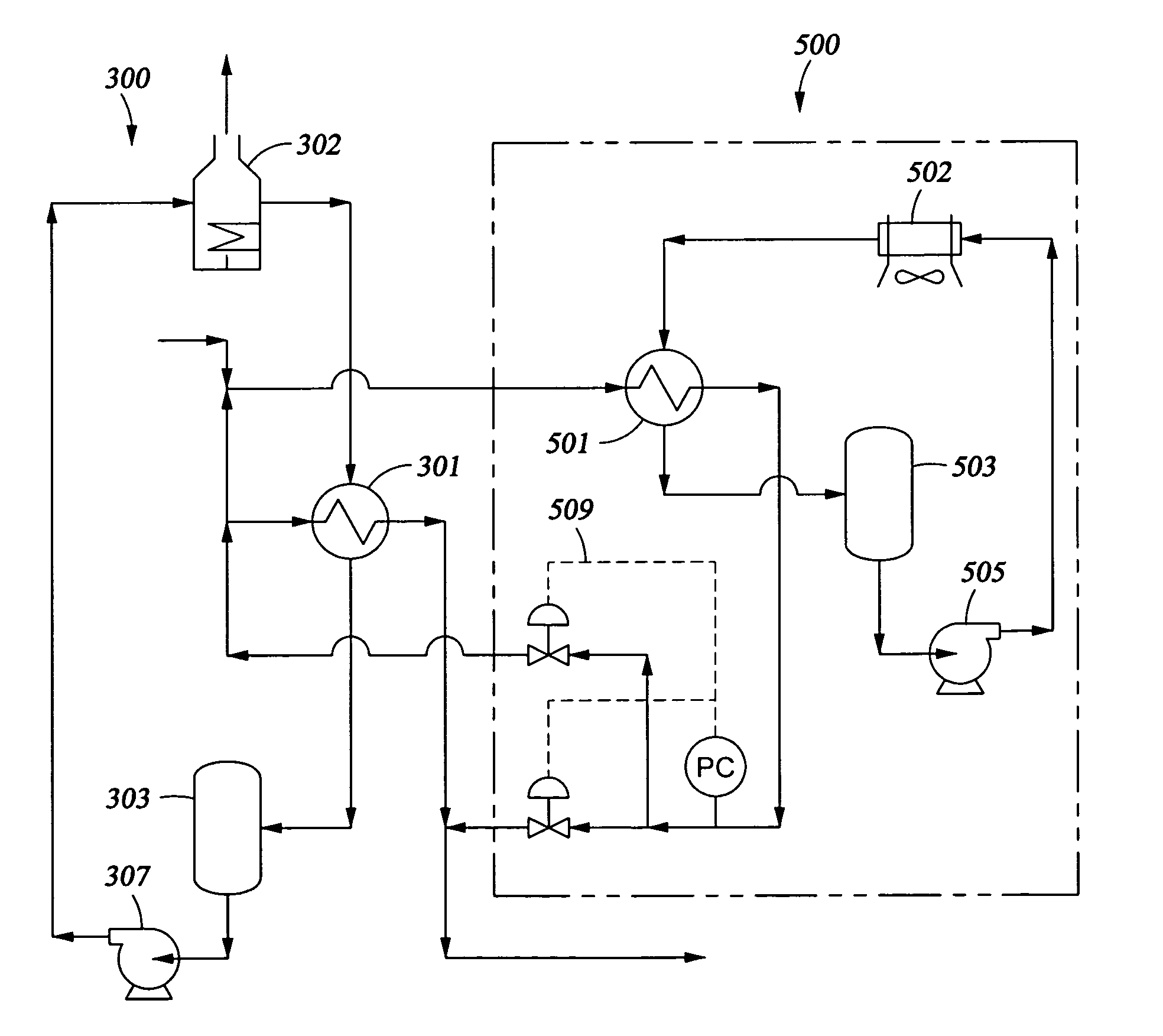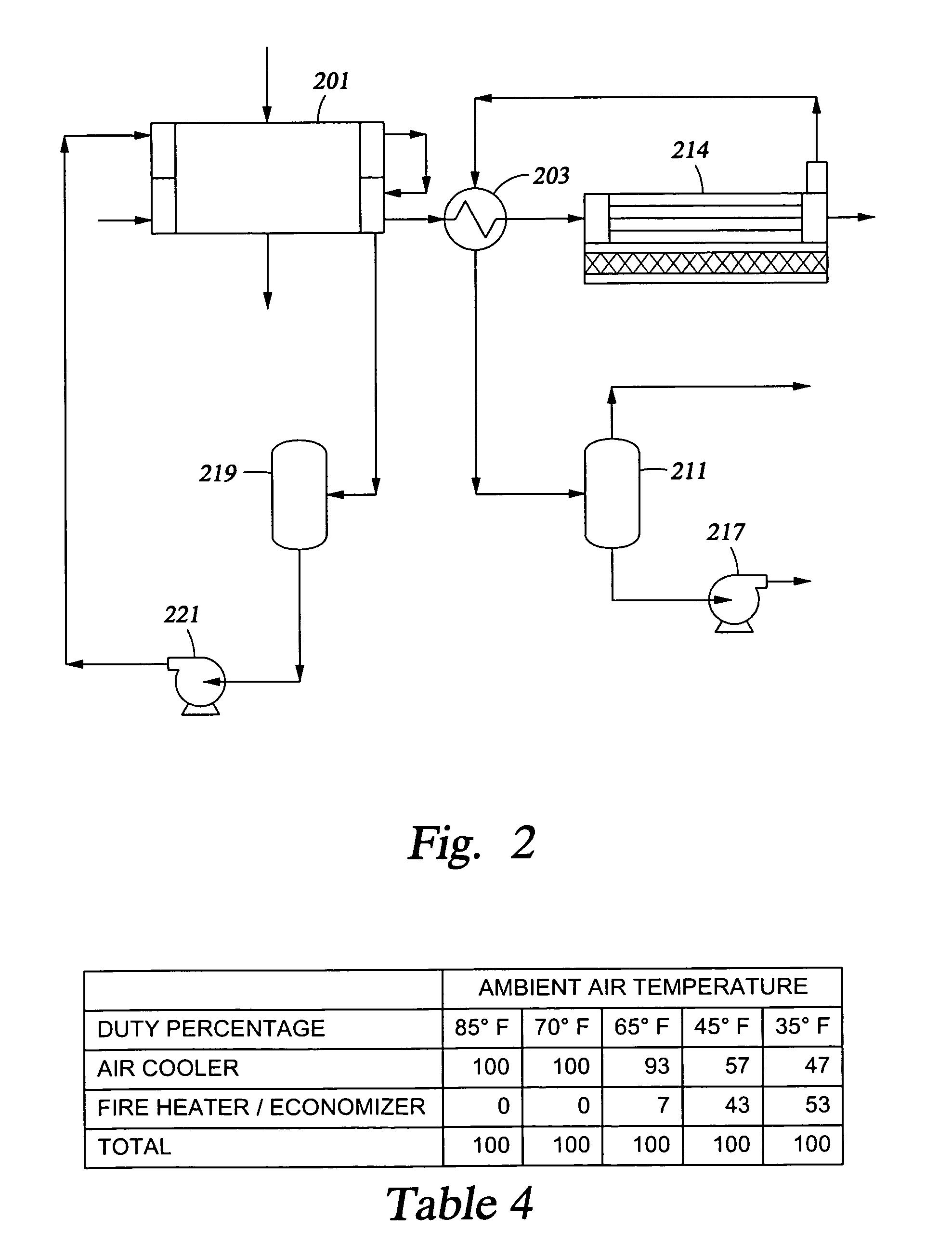Apparatus and methods for converting a cryogenic fluid into gas
a technology of apparatus and cryogenic fluid, applied in the field of cryogenic fluid, can solve the problems of gas burning, clogging up the evaporator, and not always being able to transport by pipeline,
- Summary
- Abstract
- Description
- Claims
- Application Information
AI Technical Summary
Benefits of technology
Problems solved by technology
Method used
Image
Examples
example 1
[0060]This example utilizes the apparatus and method as shown in FIG. 1 (11@−10 F, 31@50 F, 32@−10 F, and 119 at 16 psi). The cryogenic fluid is a typical LNG. The circulating fluid utilized is propane. The duty percentage for the air cooler 101, and the combined duty percentage for fired heater 105 and economizer 103 were calculated for ambient air temperatures of 35 F, 45 F, 65 F, 70 F and 85 F, with these percentages presented in the following TABLE 1. The propane circulation is about 1.7 lb propane / lb LNG, with the rate depending upon the temperature and pressure of the LNG and propane. The propane circulation range is estimated to be from about 1.0 to 2.5 lb propane / lb LNG.
[0061]
TABLE 1Duty Percentage at Various Ambient Air Temperatures85 F.70 F.65 F.45 F.35 F.Air Cooler100100957058Fired Heat / Economizer0053042Total100100100100100
example 2
[0062]This example also utilizes the apparatus and method as shown in FIG. 1 (11@−10 F, 31@50 F, 32@−10 F, and 119 at 100 psig). The cryogenic fluid is again a typical LNG. The circulating fluid utilized is propane. The duty percentage for the air cooler 101, and the combined duty percentage for fired heater 105 and economizer 103 were calculated for ambient air temperatures of 35 F, 45 F, 65 F, 70 F and 85 F, with these percentages presented in the following TABLE 2. The propane circulation is about 7.6 lb propane / lb LNG, with the rate depending upon the temperature and pressure of the LNG and propane. The propane circulation range is estimated to be from about 5.0 to 10.0 lb propane / lb LNG.
[0063]
TABLE 2Duty Percentage at Various Ambient Air Temperatures85 F.70 F.65 F.45 F.35 F.Air Cooler100100935747Fired Heat / Economizer0074353Total100100100100100
example 3
[0064]This example again utilizes the apparatus and method as shown in FIG. 1 (11@range of −10 F to 30 F, 30@−10 F, 31@50 F, 32@30 F, and 119 at 16 psig). The cryogenic fluid is a typical LNG. Rather than using propane as the circulating fluid, WBF is utilized. As with Examples 1 and 2, the duty percentage for the air cooler 101, and the combined duty percentage for fired heater 105 and economizer 103 were calculated for ambient air temperatures of 35 F, 45 F, 65 F, 70 F and 85 F, with these percentages presented in the following TABLE 3. The WBF circulation is about 10–30 lb WBF / lb LNG, with the rate depending upon the temperature and pressure of the LNG and propane.
[0065]
TABLE 3Duty Percentage at Various Ambient Air Temperatures85 F.70 F.65 F.45 F.35 F.Air Cooler100100936051Fired Heat / Economizer0074049Total100100100100100
PUM
 Login to View More
Login to View More Abstract
Description
Claims
Application Information
 Login to View More
Login to View More - R&D
- Intellectual Property
- Life Sciences
- Materials
- Tech Scout
- Unparalleled Data Quality
- Higher Quality Content
- 60% Fewer Hallucinations
Browse by: Latest US Patents, China's latest patents, Technical Efficacy Thesaurus, Application Domain, Technology Topic, Popular Technical Reports.
© 2025 PatSnap. All rights reserved.Legal|Privacy policy|Modern Slavery Act Transparency Statement|Sitemap|About US| Contact US: help@patsnap.com



